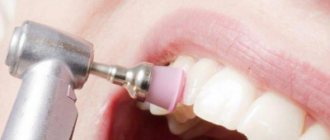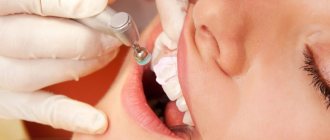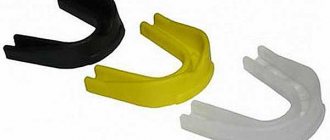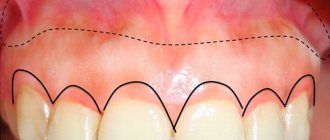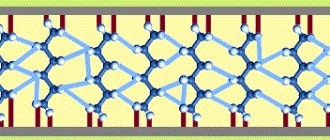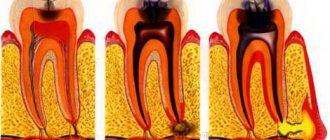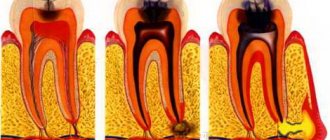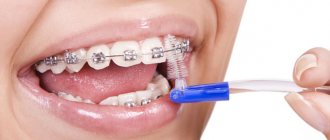For professional dental care, various methods and tools are used, among which one of the main places is grinding the enamel with subsequent polishing. The technique is used independently or simultaneously with other manipulations, for example, after removing large stone deposits. Often the method is used during preparation for other processes, for example, prosthetics or restoration with veneers.
Grinding is performed for primary processing, removal of irregularities and roughness, microcracks. At this stage, stone and soft plaque are eliminated, and caries is prevented. Polishing is carried out after grinding. They completely smooth out enamel unevenness and eliminate minor imperfections. Additionally, this step has a mild whitening effect by removing deposits. But there is a slight increase in color, as the natural shade is restored. If the purpose of the procedure is serious whitening, then the doctor uses other methods and drugs.
Teeth polishing in Moscow
Unfortunately, not many people understand the benefits of teeth polishing.
However, the effect of the procedure is noticeable almost immediately: the enamel becomes white, smooth and pleasant to the touch. In addition, there is a practical benefit from this, because the absence of cracks and protrusions makes the teeth more resistant to bacterial plaque. The deposits simply will not be able to take hold, resulting in the oral cavity remaining clean and healthy for much longer. You can get polishing done at the Moscow dental clinic Kingdom of Smiles. The company has been employing highly qualified hygienists and dentists for many years, who constantly attend various seminars and courses in order to improve their skills and gain new knowledge. By entrusting your teeth to real professionals, you can be sure of excellent results and comfortable service.
General information
Polishing your teeth is an integral part of cleaning them. It is carried out in order to get rid of unnecessary plaque, as well as to reduce the rate of formation of new ones.
After the procedure, plaque does not form on the hard and soft tissues of the oral cavity. But this is not the only advantage of the procedure - it can significantly lighten tooth enamel.
The nozzle is selected depending on what problem needs to be solved
People manage to achieve a beautiful smile, their dental health is preserved, and they don’t have to visit the dentist for a long time.
What is teeth polishing
Usually, after professional hygiene or whitening, teeth become a little rough. This is due to the fact that stone and plaque tend to penetrate the enamel structure, and after their removal, the adhesion sites remain unfilled. Upon closer inspection, shallow grooves and ridges can be found. If they are not eliminated immediately, then after a few months the person will again need the help of a hygienist.
In addition, polishing is needed immediately after installing the filling material. This is explained by the fact that the composite has a heterogeneous structure and at the same time rises slightly above the surface of the natural tooth. Because of this, it can become an ideal place for harmful bacteria and food particles to settle. Over time, all these deposits will become dense and turn into stone, which cannot be dealt with at home.
Polishing is a mandatory step when removing orthodontic braces, as well as after any surgical interventions during which the tooth was prepared. The main goal is to obtain a perfectly smooth base. This is important not only for aesthetic reasons, but also for hygienic reasons. Smooth enamel is better processed by salivary fluid, which means it is less susceptible to pathogens.
Indications for use
Many people consider polishing an unpleasant procedure, but it is not always possible to do without it.
There are certain indications for this, which include the following:
- Surgical intervention.
- Selection of material. This is necessary to ensure that the fillings match the natural color of the teeth as closely as possible.
- Smoothing of treated teeth. Often a lot of excess filling material is placed, and with the help of polishing it is possible to get rid of it.
- Correction of defects.
- Cleansing enamel from accumulated plaque. It is known to become a favorable environment for the growth of bacteria.
- Polishing is performed with the goal of achieving a beautiful smile.
- Part of orthodontic treatment for malocclusion. Polishing is carried out before installing braces and after removing them.
- Getting rid of the stone. It can cause bleeding gums, inflammation, periodontal disease and other dental diseases.
Finally, polishing paste can be used
The feasibility of the procedure is determined by the doctor.
Contraindications
Just like all dental procedures, this one has many contraindications.
The following can be included in this list:
- viral infections were detected in the patient’s body;
- tooth enamel is thinned;
- the presence of pathologies in the form of caries;
- increased bleeding of gums;
- development of inflammatory processes in the oral cavity;
- pregnancy period in women;
- diseases of the cardiovascular system.
After the procedure, the teeth become white and smooth
Before undergoing such a procedure, you should undergo an examination, after which the doctor will be able to tell whether there are contraindications or not.
Advantages
Despite the fact that the patient may experience some inconvenience during the procedure, it has many advantages:
- hard and soft tissues in the oral cavity are not injured;
- plaque and stones are carefully removed;
- the oral cavity is quickly and effectively cleansed of existing contaminants;
- correction of the shape of the filling;
- a small amount of time is required to carry out the procedure;
- no pain, no harm to enamel;
- improvement of the smile; if necessary, local anesthesia can be administered.
The procedure allows you to get rid of many dental plaques
The cost of the procedure is not high, which makes it accessible to all segments of the population.
How to polish teeth
Typically, grinding or polishing is carried out at the final stage of treatment or cleaning, so first the doctor carries out all the necessary manipulations and only then begins to level the enamel. To do this, it is very important to choose the right paste and brush of optimal hardness. The sequence of manipulations is always the same. The smoothest areas are leveled first, after which the chewing sides and spaces between individual units begin to be processed. Since different pastes are used during the work process, the order in which they are applied is also important. Formulas containing large abrasives are taken first, and then small ones.
After the tooth is smooth, it is coated with fluoride varnish to protect it from acids and bacteria that enter the mouth in large quantities every day with food and drinks. For his work, the hygienist uses a drill and various attachments. During the processing process, the enamel does not heat up much, this is due to the minimum number of revolutions of the device - no more than 5000. This allows us to confidently say that there is no harm from polishing.
Different teeth require different attachments. Cup-shaped options made of high-quality rubber are suitable for smooth crown parts. Cone-shaped brushes do an excellent job with the lumpy surface of chewing units, and plates coated with diamond chips are indispensable for polishing the side edges, that is, all hard-to-reach areas. The pastes also differ in their composition and properties: blue is used for roughing, green is used at an intermediate stage, and red and yellow are used to complete cleaning and polish especially delicate areas.
Stages of the procedure
Treatment of the tooth surface takes place in several stages. Before polishing your teeth, the doctor selects the necessary attachment and abrasive composition. Next, the following manipulations are performed:
- Cleaning flat surfaces and dental cusps. At this stage, blue or green paste is used.
- Carry out polishing using a finely dispersed cleaning composition.
- Mouth rinse.
- Applying fluoride varnish to tooth enamel.
The total duration of the procedure does not exceed 40 minutes. In this case, the patient feels quite comfortable, there is no pain.
The same sequence of actions is maintained when selective tooth polishing is carried out: not everyone knows what it is and when it is necessary. However, the essence of the manipulation is the same, only the surface of the filling or dental crown is polished.
Teeth polishing methods
Based on preliminary diagnostics and taking into account the purpose of the procedure, the dentist chooses one of the polishing methods presented today. Mechanical treatment is considered classic; it requires only a special device, which is available in absolutely every clinic. Ultrasonic grinding is used less frequently, due to the need to purchase expensive equipment.
The principle of operation in this case is slightly different: plaque and unevenness are broken into small particles due to the action of waves of different frequencies, and then washed away with strong pressure of water. This method is suitable for interdental spaces and even for tooth roots, since ultrasound can penetrate even to great depths. Another method involves using a sandblasting device. The essence of its action is to supply liquid with fine abrasives under strong pressure. The main advantage is that the risk of soft tissue injury is minimal. Also, some specialists use a laser, but a significant disadvantage is its high cost and availability only in the largest organizations.
What devices are used
Polishing is carried out using a drill with replaceable attachments. The head is selected individually for each patient. Polishing is a comprehensive cleaning that includes exposure to a device and a special paste with abrasive particles.
There are several types of drill attachments:
- Rubber cup. Ideal for cleaning flat surfaces.
- Cone-shaped brush. Designed for teeth with lumpy edges.
- Strips (strips) with aluminum or diamond coating. This attachment cleans the most difficult to reach places, namely the area between the teeth.
Restoring tooth enamel
Tooth enamel is the hardest structure in the human body, as it is exposed to mechanical damage every day - during chewing and gnawing hard food, brushing and processing.
During the procedure, the doctor first applies the coarsest abrasive paste, and finishes with a medium or fine one. This polishing effect is achieved due to silica, crushed zircon and silicate in the composition of the products. They also have a disarming effect thanks to fluoride and xylitol in their composition. Pastes with grinding particles have the following degrees of abrasiveness (indicated by the RDA index on the packaging):
- 250 – blue color. High abrasiveness for tough dirt.
- 170 - green. Medium polishing effect.
- 120 - red. Paste with fine particles for the middle or final stages of polishing.
- 40 - yellow. A soft paste designed to complete the procedure.
Contraindications
As mentioned earlier, polishing is a necessary step in many dental procedures. But there are situations when you have to refuse to implement it. The most common cause is bleeding gums. This can occur both due to the presence of an advanced stage of the disease, and due to the characteristics of the tissues, when they are very delicate and react to the slightest mechanical contact.
Also, a temporary limitation will be the diagnosis of periodontal disease or periodontitis in the acute stage, pulpitis, cysts or granulomas in the patient. The planned procedure will also have to be postponed for a short time if there are multiple carious cavities in the oral cavity. Only after completion of treatment can you begin grinding.
Most methods are not suitable for those who have very thin and sensitive enamel. Even if polishing is successful, a person may later experience unpleasant symptoms: pain, reaction to cold, etc. If the patient has a tendency to allergic reactions, the medications used by the doctor may not be suitable for him. Other contraindications include oncology, diabetes, epilepsy, kidney and heart diseases.
Polishing pastes
During the procedure, special polishing pastes are used; it is desirable that they contain fluoride preparations for the remineralization of treated dental tissues and weak antiseptic agents. The composition of these pastes is close to the composition of pastes for individual oral care, however, they are more abrasive. The following is used as an abrasive filler:
- pumice,
- silicate or aluminum oxide,
- silica,
- zircon.
Polishing pastes should be available in a full range of grain sizes. They are produced in large tubes or “unidoses” (single doses). To work, it is convenient to place the polishing paste in the ring-shaped holder.
Polishing begins with a coarse polishing paste with a rubber cup, then treatment is carried out with a medium-grained paste, thanks to which the unevenness formed by the previous paste is smoothed out. Only if you follow the order of alternating polishing pastes can you obtain a smoothly polished surface.
Finally, final polishing is carried out with a fine-grained fluorine-containing paste. In addition to the gradation of pastes by grain size, an important indicator is the RDA indicator - radioactively measured dentin abrasiveness. The lower the RDA number, the lower the abrasiveness. The higher this number, the higher the abrasiveness.
Painless teeth polishing
Before making an appointment with a dentist, many people wonder whether treatment and grinding are painful. Don't worry, because all modern methods are absolutely safe and painless. During the procedure, the enamel is erased by only 0.1 mm; this does not require anesthesia. In addition, innovative equipment makes it possible to forget about overheating of tissues, which can cause the patient to feel discomfort and an unpleasant odor.
If there is still discomfort, this indicates increased sensitivity of the upper layer of tooth tissue. In this case, professionals strongly recommend fluoridation. After treatment with fluoride-containing preparations, the effect persists for several years. If necessary, the procedure can be repeated, as it does not cause any side effects.
In rare cases, an anesthetic injection is given before grinding begins. This allows you to completely relax and trust the master. However, it is important to understand that symptoms may reappear after the freeze has stopped. If this happens, medication may be taken. They are usually prescribed in a clinic, so do not exceed the recommended dose.
A few words about grinding
Grinding is the procedure that is performed before polishing. This cleaning is considered more aggressive, since due to mechanical action it causes local stress on the enamel.
The procedure is in many ways similar to polishing; it also uses a device and a paste with grinding particles. There is also a type of air sanding that performs a gentler action. But the difference is that grinding has a greater effect and is indicated for people with pronounced dental problems.
Before and after teeth polishing
Polished enamel is very different from enamel that has not yet been professionally processed. The photo taken before the procedure clearly shows the presence of grooves and bulges on which plaque and food residues easily settle. After grinding, not a trace remains of them, the enamel becomes incredibly smooth and delicate, pleasant to touch with your tongue. In addition, it becomes several shades lighter.
Before starting polishing, it is very important to prepare the oral cavity: remove stones and plaque, and protect the lips and mucous membranes from accidental contact with rotating elements of equipment. Since you will have to sit motionless with your mouth wide open for about 20-35 minutes, it is best to install a retractor - an expander that fixes the lips in the desired position.
Thick cotton rolls are placed between the gums and rows of teeth; they prevent saliva from entering and reliably protect against accidental damage. If actions need to be performed only on one area of the jaw, then they are separated by special plates. A prerequisite is to wear glasses; they prevent liquid and paste particles from getting into the eyes. In just one session, the enamel is noticeably transformed, and the risk of re-deposition of plaque is reduced several times.
Rehabilitation after teeth polishing
Recovery after the procedure does not take much time; immediately after leaving the dental clinic, a person can return to their usual lifestyle with virtually no restrictions. In the first few days, it is recommended to adhere to a white diet, that is, give up coloring foods, coffee, black tea, red wine, fruits, beets, etc. Also, the diet should contain a lot of dairy products, which contain calcium necessary for teeth.
To maintain the effect, you will have to listen to the advice of your dentist and follow some rules. First of all, this concerns care and the daily cleansing ritual: for this it is best to purchase a soft brush and a paste with a low content of fine abrasives. You cannot drink colored drinks, eat viscous and very sticky sweets, or chewing gum. The temperature of the food should be no higher or lower than room temperature, otherwise it can cause increased pain.
It is strongly recommended to forget about cigarettes and hookah for at least a few days. Tobacco smoke contains many harmful acids, which negatively affect the protective properties of enamel and accelerate the formation of stone. Cleaning and polishing should be done at least once a year or six months if you have bad habits. This will protect yourself from developing more serious problems with your teeth and the body as a whole.
